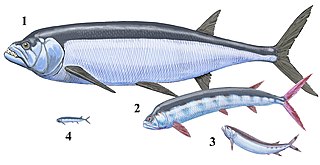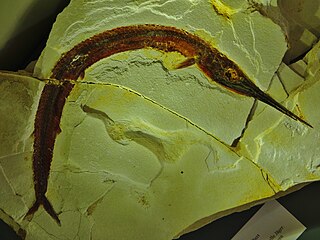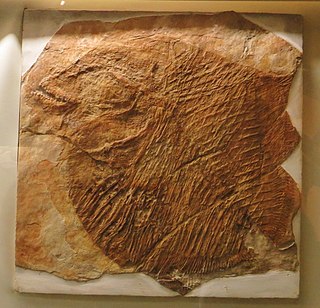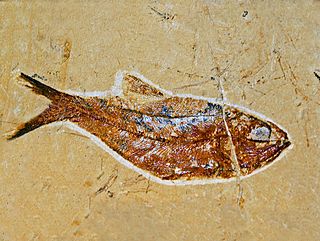
Ichthyodectiformes is an extinct order of marine stem-teleost ray-finned fish. The order is named after the genus Ichthyodectes, established by Edward Drinker Cope in 1870. Ichthyodectiforms are usually considered to be some of the closest relatives of the teleost crown group.

Belonostomus is a genus of prehistoric ray-finned fish that was described by Louis Agassiz in 1844. It is a member of the order Aspidorhynchiformes, a group of fish known for their distinctive elongated rostrums.

Apateodus is a genus of prehistoric marine ray-finned fish which was described by Woodward in 1901. It was a relative of modern lizardfish and lancetfish in the order Aulopiformes, and one of a number of prominent nektonic aulopiforms of Cretaceous marine ecosystems.
Cladocyclus is an extinct genus of marine ichthyodectiform ray-finned fish from the middle Cretaceous. It was a predator of about 1.20 metres (3.9 ft) in length.

Carsosaurus is a genus of extinct amphibious reptiles, in the mosasaur superfamily, containing only the species Carsosaurus marchesetti. It is known from a single individual that lived during the Upper Cretaceous in what is now Slovenia. The specimen is well-preserved, containing many different bones as well as some skin impressions and sternal cartilage. While more remains are needed to be certain, it is generally thought to belong to the Aigialosauridae. In life, it was an amphibious creature that spent most of its time on land, although its later relatives would become fully aquatic.
Komensaurus is a genus of basal aigialosaurid mosasauroid from the Late Cretaceous period. It was found at Komen in Slovenia in limestone dating from the Cenomanian. It was earlier referred to as the "Trieste aigialosaur". In 2007, the type species Komensaurus carrolli was named. Its holotype, specimen MCSNT 11430, was discovered in Slovenia and lived alongside the related Carsosaurus.

Aipichthys is an extinct genus of bony fish that is possibly polyphyletic. Formerly classified in the Polymixiiformes, it is now thought to be a distant relative of oarfish and opahs.

Calamopleurus is a prehistoric genus of marine holostean ray-finned fish from the Early Cretaceous of South America and northern Africa. It was a relative of the modern bowfin, with both belonging to the family Amiidae.

Coccodus is an extinct genus of marine pycnodontid fish that lived during the Late Cretaceous. The various species had a pair of massive, curved spines emanating from the lower sides of the head, and one curved spine on the top of its head. Unlike most pycnodontids, Coccodus species had a comparatively long body, giving the living animals a superficial resemblance to a scaly chimaera.

Aphanepygus is an extinct genus of prehistoric marine holostean ray-finned fish that lived during the upper Cenomanian. It inhabited the former Tethys Ocean, with remains known from Lebanon and Croatia. Its exact affinities are uncertain, although it is usually recovered as a relative of the macrosemiids. However, other authorities recover it in the Ionoscopiformes.
Cryptoberyx is an extinct genus of prehistoric marine ray-finned fish that lived during the late Cenomanian stage of the Late Cretaceous. Two species are known from southern Europe and the Middle East, both part of the former Tethys Sea.
Barcarenichthys is an extinct genus of prehistoric marine ray-finned fish that lived during the Late Cretaceous. It contains a single species, B. joneti, from the late Cenomanian of Portugal.

Anomoeodus is an extinct genus of prehistoric marine ray-finned fish belonging to the family Pycnodontidae. This genus primarily lived during the mid-to-late Cretaceous period, ranging from the Albian to the very end of the Maastrichtian age, and possibly into the Danian. The first fossils of Anomoeodus were described by Louis Agassiz in 1833, although they were described under Pycnodus. Some studies have recovered it as a wastebasket taxon.

Coelodus is an extinct genus of marine and possibly freshwater pycnodont fish. It contains only one definitive species, C. saturnusHeckel, 1854, from the Late Cretaceous of Slovenia. Other species from the Late Jurassic to the Eocene have also been attributed to this genus based on isolated dental elements, but their assignment to Coelodus is uncertain, and this genus likely represents a non-monophyletic wastebasket taxon. A potential diagnostic trait is a prearticular tooth row with three regular highly elongated teeth.
Clupavus is an extinct genus of marine ray-finned fish that lived during the middle of the Cretaceous period. It is known from North Africa, Europe, Brazil, and possibly North America.

The Calcare di Aurisina is a Mesozoic geologic formation in Italy and Slovenia. This limestones are found in the Trieste area and are of Late Cretaceous (Santonian-Campanian) age, being a local record of Carbonate platform limestones, historically quarried by cutting large blocks using steel wire, what has allowed more access to them, as numerous quarries allow excellent exposure. Due to being cut into large blocks and slabs, that usually end stored near the quarries, detailed, three-dimensional study of the rock's composition and fossils can be easily done.
Acteosaurus is an extinct genus of aquatic lizard that lived in the upper Cretaceous period. Its species, A. tommasinii and A. crassicostatus, were described in 1860 and 1993. Though A. crassicostatus is probably a junior synonym for Adriosaurus suessi, A. tommasinii was found to be similar to coniasaurs, mosasauroids, and a sister taxon to modern snakes in 2010.

The Sannine Formation, also called the Sannine Limestone, is a Cretaceous geologic formation in Lebanon. It is a Konservat-Lagerstätte that contains a high diversity of well-preserved fish, reptiles, and invertebrates from the Tethys Ocean within its three main localities: Haqel, Hjoula, and Nammoura.

Armigatus is an extinct genus of marine clupeomorph fishes belonging to the order Ellimmichthyiformes. These fishes lived in the Cretaceous ; their fossil remains have been found in Mexico, Europe, the Middle East and North Africa, suggesting the genus ranged across the Tethys Sea.

Dolichosauridae is a family of Cretaceous aquatic lizards. They are widely considered to be the earliest and most primitive members of Mosasauria, though some researchers have recovered them as more closely related to snakes.















